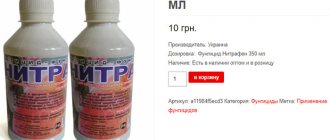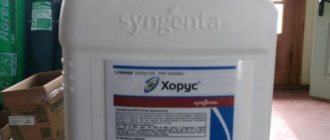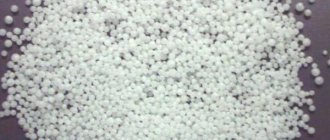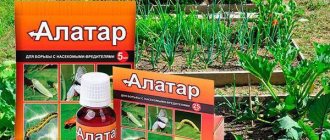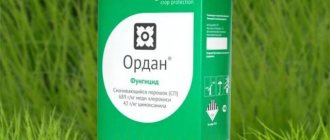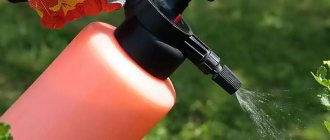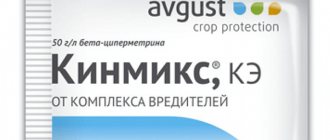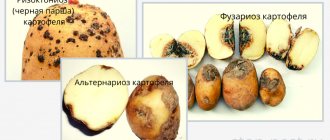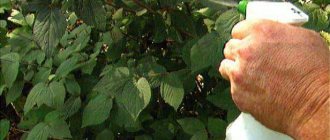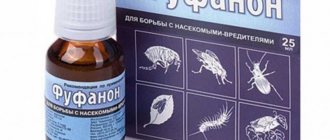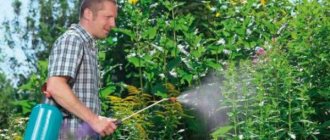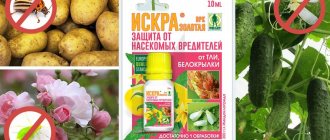Personal protective measures
When working with Dnok, it is necessary to carefully protect the skin and respiratory organs.
To do this, you should use protective clothing made of dust-proof fabric, a gas mask, gloves, and rubber boots, which are removed after pre-washing.
After spraying, you should first wash your gloves and gas mask without removing them. Do not touch protective equipment or clothing that came into contact with the drug during work with bare hands.
High guaranteed efficiency, a wide spectrum of action, ensuring an increase in the productivity of treated plants, as well as a relatively affordable price determine the uniqueness of the drug and its popularity among consumers.
Detailed description
"DNOC" is a complex preparation that combines the functions of an insecticide, fungicide and herbicide. The product is toxic and harmful to soil fauna
Great care must be taken when preparing the working fluid and spraying it
The drug has a highly toxic composition. Treatment with the product should be no more than once every 3 years. "DNOC" provides comprehensive protection against diseases, fungal infections, pests, including ticks for the entire period. Most often, the composition is used to treat vineyards and garden trees in the first spring months, as well as after leaf fall.
Manufacturers use ammonium or sodium sulfate for filling. For industrial purposes, the drug is produced in the form of a yellowish powder in tightly packed cardboard reel containers weighing 20 kg. For retail sales, the production packages the composition in sealed plastic bags in 2 g quantities. The composition has a pungent chemical odor.
Advantages and disadvantages
"Dnok", like other drugs, has pros and cons. Therefore, before making a choice, you need to familiarize yourself with them in advance.
Advantages of "Dnok":
- Versatility of use.
- Wide spectrum of action.
- Economical consumption.
- Long-lasting protective effect.
- Affordable price.
The disadvantages of the fungicide include toxicity class 2, which requires increased safety measures. In addition, you cannot spray young seedlings with “Dnok”, as this leads to a slowdown in their growth and the appearance of burns on the bark.
Networks recommend
For those who still dare to use it and want to know how plants are treated with the Dnok fungicide, the instructions should be carefully studied.
· Gardeners recommend covering it with plastic film before processing in order to prevent poisoning of the soil microflora. This will preserve the life of bacteria, microbes, worms and other beneficial inhabitants of the soil, stimulating the formation of humus and increasing the fertility of the soil.
· Some review authors dispute this method, due to the fact that the overwintering place for spores of many fungal diseases is the top layer of soil, and they advise replacing “Dnok” with preparation “B” or iron and copper sulfate.
· Users also mention a new drug - this is the insectoacaracid-fungicide “Brunka”, an analogue of “Dnoka”, which is approved for use on household plots and summer cottages in the CIS countries.
According to reviews, “Dnok” effectively helps against pests and tree diseases. Gardeners talk about how plants were treated using the Dnok product. How to dilute the product? We will definitely consider this, but a little later. In the meantime, let's talk about time and processing methods.
· It is necessary to mix the fungicide and “Preparation No. 30” - the mixture will not be washed off by precipitation for a long time, which is very helpful in the fight against scab and scale insects.
· “Dnok” should be used in the fall after leaf fall.
· It has been noticed that the use of nitrogen compounds when treating plants in the fall reduces their frost resistance. By using the drug in the spring, you can get the effect of abundant fertilizing with nitrogen fertilizers. At the same time, gardeners noticed that all the plant’s energy goes not to fighting pests, but to the development of foliage and shoots. Therefore, users recommend first treating plants with Fufanon or Plus Aktara ash solution. After leaf fall, treat with urea, and postpone the use of “Dnok” and “Preparation No. 30” until spring.
· It is also advised to treat fallen leaves with urea and bury them in trenches one and a half bayonets deep. With the arrival of spring, apply “Dnok” together with “Preparation No. 30”, and urea in the spring of next year.
Fungicide Dnok... Who used it in their garden? Your opinion... Hacienda.ru
Planting fruit trees is just the first step to growing them and obtaining a high-quality harvest. It is known that every plant in any garden needs care and attention. A mandatory procedure in garden care is spraying.
This event will rid the trees of insect pests, and will also help avoid many diseases. An effective prevention against diseases and pests of plantings is to treat them with special preparations - insecticides and fungicides. The most effective of them is the fungicide “Dnok”.
Reviews
The first thing that should be said about this drug: it is approved for use exclusively in industrial gardens and vineyards. The product is categorically not recommended for use in summer cottages and home viticulture.
The virtual space is teeming with user indignation directed against the owners of specialized sites that advertise the drug and contain information about how plants are treated with the Dnok fungicide. The reviews “appeal” to the conscience of manufacturers and sellers, demand that they refuse to sell the drug, since it is used to poison people, and threaten to contact the prosecutor’s office if there is no response.
According to other users, this tool can be used, but with caution. Some gardeners provide information that they learned from literature describing “Dnok”:
· the use of the product is permitted at a distance of at least 1 km from housing;
· You can use it once every 3 years.
Still others emphasize that the name “Dnok” is not included in the list of drugs for retail sale, and ask what amateur gardeners should do: should they use this product or not?
The drug "DNOC" - all the pros and cons
To get a high-quality harvest without hassle, it is necessary to carry out timely measures to spray fruit, vegetable and berry crops with effective agents against diseases.
Fungicide "Dnok" is one of the most effective drugs in the fight against fungal infections of plants. The manufacturer's instructions indicate that the drug is allowed to be used only in industrial gardening and agriculture.
It is not recommended to use the composition in summer cottages and private gardens.
Read also: 7 phosphorus fertilizers: types and names, their meaning and use for plants
"Dnok": plant treatment, instructions, reviews
There is another category of users. Many gardeners are loyal to this drug.
They readily argue online that the fungicide “Dnok” is indeed very poisonous; the treatment of plants with the drug should be carried out with great care and exclusively in large farm gardens (formerly state and collective farms), which are located outside the villages.
But it’s no secret that now all kinds of pests and pathogens (scale insects, false scale insects, moniliosis, clasterosporiasis, coccomycosis) have proliferated more than ever. In order to protect trees from diseases, as well as the devastating effects of pests and protect the harvest, it is necessary to use, due to its undeniable effectiveness, the fungicide “Dnok”.
Treatment of plants with this product should be carried out exclusively in industrial gardens. Fortunately, the instructions are always publicly available.
Users admit that the situation with the fungicide is rather ambiguous: on the one hand, everyone understands that it is very poisonous, on the other - what should owners of home gardens do? This poison must be used, at least periodically, by those who have no desire to lose the harvest and the trees themselves.
In general, having honestly warned fellow hobbyists about the danger, gardeners leave everyone to make their own decisions.
Many are ready to share their experience of using the fungicide “Dnok” in private gardens: plant treatment, instructions, reviews are presented in exhaustive quantities.
Users agree on one thing: in some cases, refusal to use the drug can lead to the certain death of the garden. There is no mention of a more effective pest control product in the reviews.
Conclusions and recommendations
1. It is definitely recommended for use both independently and when used together with other insectoacaricides, fungicides, etc.
2. Early spring treatment is carried out once to destroy overwintered pests and clutches of their eggs/larvae, but if necessary, repeated treatment can be carried out in mid-summer when scale insects appear.
Counterfeits of the drug “30 Plus”, photo from the site https://www.kaicc.ru/
Source: https://semena-krasnodar.ru/obrabotka/dnok-rastenij-instrukciya-otzyvy.html
Application benefits
The advantages of using Decis are:
- possibility of use against a number of major parasites in different climatic conditions;
- high speed of action;
- ease of preparation of working fluid;
- slight odor;
- achieving high efficiency when using small doses;
- moderate danger to humans and animals;
- safe for the soil (does not accumulate in it, but disintegrates after a few months);
- effective control of both adults and larvae;
- Possibility of use on indoor plants.
Did you know? Phytotoxicity, cited by manufacturers as one of the benefits, is in question. Since there is evidence from scientists who claim that in some cases the use of Decis can cause burns to young leaves. In the reviews of people who used it, there is no information about yellowing of the foliage.
Reviews from gardeners about the use and effectiveness of the drug are mostly positive. According to surveys of people who have been successfully using the product on their plots for several years, Decis scored 8 points out of 10.
Storage period and conditions
Insectofungicide "DNOC" is valid for 3 years from the production date indicated on the packaging. The drug should be stored away from food, utensils and medicines. The place should be dark, dry, inaccessible to children and pets. Keeping the chemical near fuel and lubricants or in a room with gasoline vapors is strictly prohibited.
The chemical must not be disposed of with household waste. It also cannot be burned or buried. Its processing is carried out only by a special service for the disposal of highly toxic waste.
Reviews about "DNOC" are quite contradictory. However, experienced gardeners consider it one of the most effective remedies and use it in their garden plots, despite all the warnings. The insectofungicide is not a prohibited drug, but it must be used with extreme caution.
Area of application
Dnok provides maximum plant protection, which is why it is the most common preparation. At the same time, there is a passionate debate surrounding it: is it possible to use such a poisonous product in a private garden. Many experienced gardeners give good reviews and advise it to beginners, but they warn that high efficiency also has a downside.
The instructions clearly indicate that the drug Dnok is allowed for use only in gardens and vineyards belonging to large farms. It cannot be used on personal farmsteads and in dacha cooperatives.
The fact that the product is packaged in 50 g bags suggests that the manufacturer of the pesticide intends to use it not only on an industrial scale, although the instructions strictly prohibit this. Dnok is sold in regular stores for gardeners and gardeners. Its area of application is fruit trees, berry bushes and grapes.
Analogs
In the absence of "Dnok", you can use other chemicals that have a similar effect. Each of them must be used in accordance with the attached instructions.
Analogues of "Dnok":
- Clean Garden Nitro.
- Brunka.
- Nitrafen.
- Clean Garden.
The spraying preparation Dnok is highly effective when used correctly. But the high level of toxicity does not allow its widespread use. Therefore, experts recommend using “Dnok” only in special cases when gentle drugs have not brought positive results. And we should not forget that this remedy can be used no more than once every 3 years.
When and how to use a fungicide
The main processing period is early spring. You need to “catch” the moment even before the buds open, when a stable temperature is established at +4...+5 °C.
Experienced gardeners know that this is the best time for such work: the juices are not yet circulating, and harmful insects are still in the wintering stage, so they are easy to remove.
Did you know? D. I. Mendeleev stood at the origins of domestic agrochemistry. The legendary scientist was interested in the effect of lime and superphosphate on subarable soil layers.
Among the “clients” of the powerful solution are aphids, scale insects, various mites, copperheads, leaf fleas and other carriers of diseases that like to gather on trees and shrubs.
The drug is used much less frequently during autumn treatment. Here you will have to wait until the leaves fall. Keep in mind that even in low concentration the solution can be used no more than once in 3 seasons. Frequent spraying will do more harm than good.
When preparing the mixture, try not to spill it. As we already know, the powder is reluctant to be diluted in water. Many people find a way out by making the solution in this way:
- 50 g of fungicide (standard packaging) is carefully diluted in a 1-2 liter container.
- Then the resulting concentrate is poured into a 10-liter container, not forgetting to mix vigorously.
Now let's see what the consumption rates are for different crops.
Apple, pear, quince
Here the concentration will be one of the most intense - per 100 square meters. m of plantings will require 15 liters of solution.
Important! The presence of soil near an array of trees or bushes used for planting vegetables or other crops significantly increases the labor intensity of the procedure. “Border” areas are often covered with a film that prevents liquid from penetrating into the soil.
This preserves its balance.
Timely spraying will prevent the appearance of scab, moniliosis and various kinds of spots on the leaves. Aphids and leaf rollers will also have minimal chances.
Peach, apricot, cherry, plum
For the same area you will have to take no more than 10 liters. This will prevent moniliosis and clasterosporiasis from developing. The risk of characteristic curling is significantly reduced. Ticks and scale insects do not tolerate such solutions.
Gooseberries, currants
Actively growing bushes with powerful rhizomes require an appropriate dose - 15 l/100 “squares”.
The leaves will stop becoming spotted and curling. The appearance of leaf fleas or moths is unlikely, and this is where the strong insecticidal effect of this product is manifested.
Grape
The use of such strong drugs as DNOC for processing grapes has its own characteristics.
Experienced gardeners often use fungicides such as “Abiga-Pik”, “Fundazol”, “Khom”, “Tiovit Jet”, “Fitodoctor”, “Tanos”, “Oksikhom” to combat various diseases of grapes.
With the onset of heat, you will have to start pruning, which will prevent harmful larvae and spores from spreading. They begin to spray immediately after such thinning, without waiting for the juices to “run” along the branches.
Consumption - about 8 liters per area of 100 square meters. m. After this, you can forget about suckers and ticks for the whole season. If you do it on time, in early spring, you can protect the vineyards from the painful “rust” that often affects the leaves at the beginning of summer. The same list includes septoria and anthracnose.
Did you know? From the early 1960s until its collapse, the USSR held the world leadership in the production of mineral fertilizers. On the other hand, many collective farms simply had nowhere to store the received “feeding”, and this turned into two extremes - often the soils were oversaturated with nitrogen or they did not transport valuable material to the field at all, dumping it in ditches.
You may have noticed that the instructions indicate large areas. This is logical, because the main consumers of the solution are large farms with huge gardens
Farmers need to pay special attention to “safety precautions” when working with a strong product
Standards for fruit and berry crops
To prepare a solution for quince, apple and pear trees, use the most saturated solution. Here you need 15 liters of ready-made mixture per 100 sq. m. It should be noted that labor costs for the procedure increase when there are dense thickets of bushes and trees in the immediate vicinity. It is better to protect adjacent areas with film. It will prevent the mixture from seeping into the soil. Due to this, it will be possible to maintain balance in the soil.
If all processing rules are followed, the crop will not be endangered by pests
For apples, pears and quinces, the drug is used to prevent moniliosis, scab and other diseases accompanied by the formation of spots on the leaves. DNOC is effective against leaf rollers and aphids.
If you have to process plums, apricots, peaches and cherries, take no more than 10 liters per area. Thanks to this, it is possible to avoid klyasterosporiosis and moniliosis. The characteristic curliness is eliminated. Scale insects and mites are very sensitive to such solutions.
Currant and gooseberry bushes, which are in the active stage of growth, have a powerful rhizome. They require a dosage of 15 liters per 100 square meters. m. This will get rid of curling and spotting of leaves and the appearance of plaque. A leaf flea attack is unlikely.
Instructions for using DNOC for grapes have their own characteristics. As soon as the warm season arrives, pruning is done to prevent harmful spores and larvae from spreading. After this procedure, immediately spray the drug, without waiting for the sap to run along the branches. Consumption for grapes is 8 liters per 100 sq. m.
The use of DNOC in viticulture eliminates the need to fight mites and lungwort for the whole season. If you carry out this manipulation in early spring, you will be able to avoid rust that affects the foliage in June. Other diseases that the drug can treat include aracnose and septoria.
The main users of the solution are owners of large garden farms. Farmers try to pay maximum attention to safety when working with a strong product.
Precautionary measures
This powerful product has a complex effect and requires careful handling. This applies to both granules and the finished mixture.
Yellow granules are not just a source of toxic compounds - they are also explosive. According to the manufacturer's instructions, plantings should be sprayed at a distance of 1 km from pastures and residential buildings. It turns out that the drug is not suitable for a private farmstead. In practice, this rule is ignored by many.
Safety precautions regarding other important points come down to the use of specialized clothing, a respirator, and boots. The head should also be protected; ideally, it is better to wear a gas mask. Recommended:
- Carry out processing in calm weather.
- Avoid contact of liquid with exposed skin and mucous membranes.
- Remove people and pets from the immediate area. It is imperative to notify your dacha neighbors about the planned event.
- When the treatment is completed, do not handle dirty clothes, otherwise skin irritation will occur. It will not be possible to wash off the solution in one go.
After spraying, you must wash the sprayer thoroughly, avoiding draining it into wastewater. Also, after spraying the plants, you should take a shower. DNOC poses the greatest danger to the skin and respiratory tract. It has a significant effect on metabolism, and in some cases can lead to chronic diseases. To do this, it is enough to ingest even a minimal dose of the solution.
The shelf life of the insectofungicide is 3 g. The release date is indicated on the packaging. The bags must be placed in a dry room, away from food and containers for storing them. It is dangerous to keep them near fuels and lubricants. Even diesel and gasoline vapors can lead to unexpected consequences. The price of the interfungicide depends on the manufacturer. A 50 g package can cost 50 rubles or more.
Fungicide Dnok: instructions for use for plants, trees, grapes, composition
Every gardener understands that it is impossible to grow a good harvest without treating pests and diseases.
Now the range of chemicals is very diverse, but only some of them have a wide spectrum of action and combine acaricidal, insecticidal and fungicidal properties at the same time.
One of these universal products is the spraying drug Dnok. But in order to use it correctly, you must first study the instructions.
The lasting effect of using “Dnok” lasts for 1 month
Treatment of fruit trees with Dnok
The drug "Dnok" is recommended for use on stone fruit trees (apricot, plum, cherry, peach) and pome crops (apple, pear, quince).
Treatment should be done against the following pests:
- scale insect;
- types of ticks;
- slowpoke;
- leaf roller;
- mole;
- aphid;
- psyllid;
- moth.
Also, timely spraying of trees with “Dnok” helps to destroy pathogens of curl, spotting, clasterosporiasis, coccomycosis, moniliosis and scab. The consumption rate of the fungicide working solution is 10-15 liters per 100 square meters. m of plantings.
How to use Dnok for grapes
Before processing this crop, pruning should be done first. You must begin the procedure immediately after completing the preparatory stage.
Treating grapes with “Bottom” helps prevent the spread of mites, scale insects and aphids. As a fungicide, this drug is effective against:
- anthracnose;
- oidium;
- spotting;
- cercospora;
- necrosis.
The consumption of the Dnoka working solution in this case should not exceed 8 liters per 100 sq. m. m.
It is necessary to spray before the sap begins to flow in the plants.
Spraying berry bushes with Dnok
This drug is also recommended for processing gooseberries and currants. According to the instructions, it helps to get rid of:
- aphids;
- scale insects;
- leaf rollers;
- moth;
- false scale insects;
- ticks.
The use of this fungicide against diseases such as powdery mildew, septoria, rust, spot and anthracnose is also justified. The flow rate of working fluid when spraying shrubs should be within 15 liters per 100 sq. m. m.
Advantages and disadvantages
"Dnok", like other drugs, has pros and cons. Therefore, before making a choice, you need to familiarize yourself with them in advance.
Advantages of "Dnok":
- Versatility of use.
- Wide spectrum of action.
- Economical consumption.
- Long-lasting protective effect.
- Affordable price.
The disadvantages of the fungicide include toxicity class 2, which requires increased safety measures. In addition, you cannot spray young seedlings with “Dnok”, as this leads to a slowdown in their growth and the appearance of burns on the bark.
Precautionary measures
Judging by the reviews, “Dnok” (double blow) is one of the most effective drugs that have a detrimental effect on most common garden pests and fungal pathogens. But it must be used with caution.
Work with the fungicide should be carried out in special clothing and a protective mask on the face, since severe irritation occurs when the solution comes into contact with areas of the skin and mucous membrane. The fungicide can be used no closer than 2 km from water bodies.
After spraying, you need to take a shower, wash your work clothes, and wash the spray bottle with a soda solution. If you accidentally swallow the working preparation “Dnoka”, you should not drink alcohol, hot drinks, fats, or make compresses.
Important! For humans, a concentration of dinitroorthocresol of 70-80 mcg per 1 ml of blood is lethal.
The fungicide can be stored only if the integrity of the packaging is maintained. The shelf life of the powder is 3 years from the date of production. The product should be stored in a dark, dry place out of reach of children.
Dnoka powder is explosive, so do not place the product near containers with flammable liquids.
How long can diluted Dnok be stored?
The shelf life of the prepared Dnoka solution does not exceed 2 hours. Therefore, the product must be used immediately after preparation. In this case, it is necessary to clearly calculate the required amount of the drug for processing, since it is impractical to prepare it for future use.
Important! During disposal, do not allow any remaining working solution to enter a body of water or running water.
In the absence of "Dnok", you can use other chemicals that have a similar effect. Each of them must be used in accordance with the attached instructions.
Analogues of "Dnok":
- Clean Garden Nitro.
- Brunka.
- Nitrafen.
- Clean Garden.
Conclusion
The spraying preparation Dnok is highly effective when used correctly. But the high level of toxicity does not allow its widespread use.
Therefore, experts recommend using “Dnok” only in special cases when gentle drugs have not brought positive results.
And we should not forget that this remedy can be used no more than once every 3 years.
Reviews about the drug Dnok
Sergey Smilyakov, 45 years old, Bryansk
I have been familiar with the fungicide “Dnok” for about 10 years, since my professional activity is connected with farms specializing in growing fruit trees and berry bushes.
This product is really effective against a complex of pests and fungal diseases, but its use is associated with certain risks, since the fungicide has an increased level of toxicity.
Therefore, using it privately is not entirely justified.
Oksana Kozakovskaya, 52 years old, Samara
I learned about “Dnoka” from a friend of mine who grows apple and pear trees on a professional scale. Indeed, he confirmed the effectiveness of this remedy against a complex of fungal diseases and wintering pests on these crops.
But at the same time, he warned against using it on my personal plot, since use close to residential buildings at a distance closer than 1 km is prohibited.
Therefore, I have no personal experience of using the Dnok fungicide, since all the shrubs and trees are planted next to the house.
Source: https://fermilon.ru/sad-i-ogorod/vrediteli/preparat-dnok-dlya-opryskivaniya-i-obrabotki-sada-otzyvy.html
Composition of the drug Dnok and release form
The drug is produced in Ukraine. For those with an agrotechnical education, we will present the empirical formula of the active substance in the composition of the drug - C7H9N3O5. For those less knowledgeable on the topic, let us explain that the product contains a very strong substance - a pesticide - 4, 6 -dinitro-o-cresol, which has a hazard class of 2 according to its toxic characteristics.
For gardeners, the drug is available in plastic packaging in a volume of 50 grams. Such a small dosage is due to the maximum effectiveness of the drug, as well as increased toxicity.
The drug itself is a powder in the form of small granules, with a yellowish tint and a pronounced pungent odor. The powder is also explosive.
There are many opinions about the use of the drug. Thus, it is noted that it is unsafe. Experts in the field of pesticides note the inadmissibility of its use in sanitary zones, near water bodies, as well as within a kilometer from villages and settlements. Other reviews note the effectiveness of this product when used in industrial crop production, in particular in industrial vineyards and fruit and berry orchards. The cost-effectiveness of the product is also noted. Thus, one treatment in early spring or late autumn makes it possible to get rid of pests and diseases of fruit and berry crops for 3 years. It is for this period that the action of the fungicide is designed.
An important feature of “Dnok” is its poor solubility in water, in which case it is recommended to use organic solvents, for example, urea. During the first day after treatment, the fungicide, penetrating the soil and plant, fights cells, spores and pests that cause diseases
The visible effect occurs already on the 4th day
During the first day after treatment, the fungicide, penetrating the soil and plant, fights cells, spores and pests that cause diseases. The visible effect occurs already on the 4th day.
This fungicide is available under several trade names, such as “Sinox”, “Dinon”, “Celion”, “Crezot”.
Experienced agricultural technicians note that this drug is intended for use in large industrial farms. In small gardens and household plots, the use of the drug is impractical, and most importantly, unsafe.
It is also noted that even in industrial conditions the drug is used to prepare the soil for planting fruit crops. As a rule, soil disinfection with the drug is carried out in the fall.
Effect of the drug
The complex preparation “DNOC” is effective in combating not only mycelium and plant diseases, but also contributes to the death of pests. The product can be used against crop damage:
- scale insects;
- ticks;
- aphids;
- moth;
- leaf rollers;
- copperhead, etc.
The drug reaches its maximum concentration in the green parts of plants 2 days after treatment. The composition retains its protective and therapeutic effect on the culture for 1 month.
What to do if you are poisoned by insecticides
Insecticide poisoning is not such a rare situation
Therefore, if you plan to use these drugs in your home or area, be sure to pay attention to the hazard class and also follow safety regulations. Wear glasses, gloves and a mask or respirator
If drugs come into contact with the skin, wash them off with soap and water. In case of contact with eyes, rinse them thoroughly with running water. If insecticides get on the mucous membranes and in the digestive tract, it is recommended to induce vomiting and consult a doctor.
After working with insecticides, you must wash your hands and face with soap and rinse your mouth. It is best to immediately take a shower and wash the clothes used when treating plants with insecticides against pests.
You can work with insecticides for no more than an hour. In this case, you cannot use food containers to prepare solutions, and it is strictly not recommended to store ready-made solutions.
Insects can harm not only your green pets, but also loved ones and pets. How to protect your family during a country holiday - read on our website:
Features of using the product
You can use the drug DNOC for spraying only in special clothing. Work must be carried out wearing gloves, goggles, a gas mask and rubber boots. You can work with the drug for a maximum of 2 hours. Used workwear must be washed and left in a separate room. The preparation of a solution based on DNOC should take place in the open air, away from residential buildings, sources of water and fire.
The drug can be used for 3 years. At the end of its shelf life, the packaging cannot be disposed of in the standard way. It is necessary to hand over the remaining product to a special organization for disposal.
How to prepare a working solution of insecticides basic principles
It is necessary to dilute insect repellent preparations with water to a working condition while wearing protective clothing, goggles, a respirator, and always in strict accordance with the instructions. However, the preparation of most working solutions of insecticides requires compliance with several important conditions:
- using the right water;
- carrying out processing at optimal air temperature;
- preparing the working solution in accordance with the instructions.
What should the water be like?
Water with neutral acidity (pH 7) or slightly acidic (pH 5.5) is best suited for preparing an insecticide solution. At a pH above 7, a number of drugs lose their properties. Some gardeners use citric acid (3-5 g per 10 liters of water) or a 9% solution of acetic acid (5 ml per 10 liters of water) to acidify water.
The optimal water temperature for preparing the solution is 10-16°C. Often gardeners use water from wells, artesian wells or open reservoirs. In this case, it is better to prepare it in advance so that the water, after standing, reaches the required temperature. In cold water, drugs dissolve less well, and, as a result, the effectiveness of treatments decreases. It is not recommended to heat the water before preparing the solution, since in this case it loses some of the oxygen.
Optimal air temperature
When treating plants or soil with insecticides, be sure to take into account weather conditions and observe the temperature conditions indicated on the packaging.
The optimal air temperature for treating plants with insecticides is 12-22°C. At lower or, conversely, higher temperatures, the processing efficiency is significantly reduced. However, some insecticides of the pyrethroid class can be used even when the air warms up to 7°C. In any case, you should always carefully read and observe the temperature conditions indicated on the drug packaging.
Preparation of insecticide solution
Step 1. Take a suitable container and pour 1/3 of the required volume of water into it.
Step 2. Add emulsion, powder or water-soluble granules, mix thoroughly until the drug is completely dissolved (usually this takes about 5 minutes).
Step 3. Add the remaining water and stir again.
The prepared working solution cannot be stored. Use it immediately after preparation or within the time specified in the instructions for the drug.
If you are using a liquid product, shake it thoroughly before use to eliminate separation of the composition and dissolve any precipitate that has formed.
Active substance and mechanism of action
The main substance is 4,6-dinitro-o-cresol. The solution, falling on the leaves and stems, destroys the cells of harmful fungi, interrupts the disease itself at an early stage and eliminates the insects that cause such diseases.
The effect after spraying occurs after 3-4 days, although the penetration of dinitro-o-cresol into infectious spores usually takes 2 days. This is enough to neutralize the source of infection and eliminate it in a short time. A lasting effect is observed for at least a month.
Insecticides list of popular drugs
Translated from Latin, insectum means insect, and caedo means I kill. There are many drugs that can cause significant damage to an army of pests in your area.
However, in order not to make a mistake with the choice, you need to pay attention to the composition of insecticides, hazard class, validity period, permissible time for treating plants and the list of insects susceptible to the influence of drugs
| Drug name | Active substance | Features of the use of insecticide |
| Aktara | Thiamethoxam | Systemic insecticide of contact-intestinal action. Available in the form of granules that dissolve in water, as well as in liquid form. Used for protection against thrips, scale insects, scale insects, Colorado potato beetles, aphids). Can be used in the garden and also for indoor plants. The drug is resistant to sun and precipitation. It is effective for 14-28 days when sprayed and 40-60 days when applied to the soil, but may cause resistance in insects. |
| Alatar | Malathion Cypermethrin | Broad spectrum insecticide thanks to two components in the composition. Has an intestinal contact effect. Protects potatoes, root crops, berries and fruit crops, as well as ornamental trees and shrubs, open ground flower crops from a range of pests. |
| Anti-mite | Malathion | Contact-intestinal acaricide, effective against various types of spider mites. It is used for processing a wide range of crops: vegetables, fruits, berries. The effect is observed within a few hours after treatment. The period of protective action is 15 days. |
| BioKill | Abamectin | Broad-spectrum insectoacaricide. Indispensable for protecting plants from pests during the period when there is very little time left before harvesting. Protects against pests of currants, gooseberries, raspberries, apple trees and other fruit trees, tomatoes, flowers (garden and indoor). The effect is observed within a few hours. Works well even in hot weather. |
| Grom-2 | Diazinon | Garden insecticide in granules that should be spread over the surface of the soil. Effective in the fight against garden ants and mole crickets, which begin to die after 1-2 days. The drug belongs to hazard class 3, but is extremely harmful to fish and birds. Grom-2 is able to protect the garden from insects for several months. |
| Inta-Vir | Cypermethrin | A popular contact-intestinal insecticide for the control of aphids, whiteflies, thrips, leaf-eating caterpillars, Colorado potato beetles, cherry and carrot flies, codling moths, weevils, and fungus gnats. Available in the form of tablets that must be dissolved in water. Up to 3 sprayings of plants per season are allowed, but treatment cannot be carried out during flowering, or less than 20 days before harvest. |
| Spark Double Effect | Cypermethrin Permethrin | Insecticide of contact-intestinal action. Used to control aphids, thrips, whiteflies, weevils, mealybugs, scale insects and false scale insects. The drug belongs to the third class of danger. Available in tablets that require dissolution in water. Plants can be sprayed no more than once every 20 days. |
| Confidor Extra | Imidacloprid | Systemic drug of contact-intestinal action to combat aphids, whiteflies, scale insects and thrips. Resistant to temperature fluctuations and precipitation. It acts for 15-30 days, penetrating into the roots and leaves of plants. The main advantage is the extremely economical rate of insecticide consumption. |
| Tanrek | Imidacloprid | Systemic drug for the control of aphids, whiteflies, and Colorado potato beetles. Protects plants for 4 weeks. Can be used for drip irrigation. Effective at various temperatures. |
| Fitoverm | Aversectin S | Biological product based on waste products of soil organisms. Available in ampoules. Affects spider mites, aphids, Colorado potato beetles, cabbage whites, and apple codling moths. This drug belongs to the third class of danger; it destroys insects by contact-intestinal method, affecting the nervous system and causing paralysis. The drug is not phytotoxic and does not pollute the environment, and it works even on the hottest summer days. Fitoverm cannot be mixed with other drugs. |
| Fufanon-Nova | Malathion | An aqueous emulsion that is suitable for treating garden and indoor plants against mites, thrips, aphids and whiteflies. The drug is effective for 5-10 days, but is washed off by rain. It is not recommended to spray plants during flowering, or to mix the emulsion with other preparations. The insecticide belongs to the third class of danger, but is harmful to bees. |
DNOC – a preparation for spraying garden crops
Fungicides are used to combat diseases of fruit and berry crops. One of these products is DNOC - a preparation for spraying vegetables, berries and fruits in the garden. It is a strong insectofungicide. Its use is possible only after reading the instructions.
Composition of the product and its release form
DNOC consists of dinitroorthocresol. The substance is an acaricide and fungicide. The drug is sold in packages of 50 g. In one package, the concentration of dinitroorthocresol is 40%. Additionally, the product contains sodium sulfate and ammonium sulfate. The product is a granular powder. Its color is yellow.
The drug has a pungent odor. Analogues of the drug DNOC are such drugs as Dinozal, Cresotone and Selinon.
DNOC spray preparation and its effect
According to the instructions, the drug DNOC is an insectofungicide. It is characterized by a triple action. It is a strong fungicide that fights fungi. The drug also has a herbicidal effect, reducing the growth of weeds. DNOC acts as an insecticide, that is, it actively fights pests.
The product has a long-lasting effect. After spraying shrubs with it, effectiveness is ensured from 1 to 3 years. DNOC is slightly soluble in water.
Dinitroorthocresol, after contact with the stems and leaves of treated plants, kills fungal cells. The substance also provokes the death of pathogens of garden crops.
Dinitroorthocresol begins to act two days after treating plants with it. The spraying preparation DNOC shows its full effectiveness 3-4 days after spraying. The product has a protective effect on treated plants for 30 days.
The drug fights plant diseases such as:
DNOC is effective in the fight against gray mold, powdery mildew and clasterosporiosis. The drug destroys aphids, copperheads, moths and leaf rollers.
DNOC is toxic. It can only be used to treat large garden plots. The drug should not be used in a small area.
DNOC – preparation for spraying: instructions for use
Before use, the product must be mixed only with an organic solvent.
This can be acetone, turpentine, white spirit or alcohol. The solution is made according to the following scheme:
- 1 liter of solvent is poured into a clean container.
- 50 g of fungicide is added to it.
- The mixture is mixed with 10 liters of water.
- The solution is mixed.
The mixture is poured into an automatic spray bottle and sprayed onto the plants.
According to the instructions, treatment of plants with DNOC should be carried out according to the following scheme:
| Type of crop processed | Pest type | Disease | DNOC consumption in liters per 100 m2 |
| Apple and pear trees | Aphids, copperheads, moths, leaf rollers and mites | Scab and moniliosis | 15 |
| Currants and gooseberries | Aphids, moths, leaf rollers and mites | Powdery mildew. Anthracnose and septoria | 15 |
| Cherries, plums, peaches and apricots | Aphids, suckers, moths, leaf rollers | Coccomycosis and klyasterosporiosis | 10 |
The product is used for spraying grapes. It is used to combat aphids and scale insects. The drug is used to treat grape necrosis, anthracnose and cercospora. There should be 8 liters of fungicide per 100 m2 of vineyard.
DNOC is used in spring, autumn and summer. In spring, shrubs and trees should be sprayed at a temperature of 13-20 0 C. The plants themselves should not yet have buds. The soil adjacent to trees and shrubs must be covered with a tarpaulin.
The preparation for spraying DNOC in autumn should be used after the period of leaf fall. The air temperature should be up to 5 0 C. When processing, it is recommended to water the soil adjacent to trees and shrubs. This will not have a negative effect on her fertility.
DNOC should not be combined with other pesticides. Do not use the product at high temperatures due to its evaporation.
Treatment with the drug should be carried out away from home and pastures. The distance between the processing site and buildings must be at least 1 km.
Features of using the product
You can use the drug DNOC for spraying only in special clothing. Work must be carried out wearing gloves, goggles, a gas mask and rubber boots. You can work with the drug for a maximum of 2 hours. Used workwear must be washed and left in a separate room. The preparation of a solution based on DNOC should take place in the open air, away from residential buildings, sources of water and fire.
The drug can be used for 3 years. At the end of its shelf life, the packaging cannot be disposed of in the standard way. It is necessary to hand over the remaining product to a special organization for disposal.
Treatment of plants with DNOC - video
Consumption rates
| Culture | Disease | Pests | Consumption per 100 sq. m, l |
| Apricot, plum, peach, cherry | Spotting, leaf curl, clasterosporiosis, moniliosis, coccomycosis | Honeyweed, mites, leaf rollers, scale insects, moths, red-headed aphids | 10 |
| Quince, apple, pear | Moniliosis, scab, rot | Scale insects, psyllids, aphids, mites, leaf rollers, false scale insects, copperheads, moths, moths | 15 |
| Grape | Oidium, anthracnose, spotting, necrosis, cercospora | Scale insects, aphids, mites | 8 |
| Gooseberries, currants | Rust, spotting, powdery mildew, septoria, anthracnose | Leaf rollers, aphids, mites, scale insects, moths, false scale insects | 15 |
Acquaintance
Practice has shown that “Dnok” is one of the most effective drugs for ensuring complete protection of vineyards and fruit and berry crops from pests, diseases, fungal diseases, mites, etc. The use of a 1% concentration of the drug during the period of bud swelling does not affect the annual growth, does not have a negative effect on the condition of the leaves, does not cause the ovaries of fruits and berries to fall off. Used to treat trees and vineyards in early spring and autumn.
The start time of the drug's effect is 3-4 days after spraying. The protective effect lasts for 30 days.
Terms of use
The effectiveness of the drug "DNOC" depends on the timely processing of fruit and berry crops. Experienced gardeners note only two periods suitable for spraying with fungicide.
Treatment in spring
Often, plants are treated with a fungicide in early spring, while the buds have not yet had time to bloom. You should wait until the frosts end and the temperature is not lower than +4 °C
It is important to carry out the treatment before the juices begin to flow, then the effect of the drug will be more effective. In addition, during this period it is easier to destroy insects that have not yet emerged from the winter.
Before spraying, cover material should be placed on the ground to prevent toxic substances from getting into the ground.
Plants are treated with fungicide in early spring
Compound
It is important to calculate the correct concentration of the product. The solution, which contains 1% of the drug, is harmless to plants, including at the stage of swelling of buds and buds. Spraying with diluted liquid does not cause mutational changes in crops, leaf fall, or slower formation of ovaries.
The active ingredient of the drug is C7H6N2O5, called dinitroocresol. It is a broad-spectrum pesticide that can be used as a fungicide, herbicide and insecticide.
Attention!
The product is highly toxic. DNOC should not be used to treat small areas.
Treatment in autumn
"Dnok" is a pesticide with complex, contact-eradicative action. It provides for the simultaneous manifestation of insecticidal, acaricidal, fungicidal and herbicidal activity. Precipitation and high air humidity are favorable conditions for pests and pathogens to penetrate into the bodies of shrubs and fruit trees.
Conditions of humidity and low soil temperature contribute to the penetration of the working solution into the soil to a depth of 7 cm, where it has a pesticide effect. As the temperature rises and the soil dries out, the drug moves to the top layer.
Autumn is considered the period of effective use of the drug "Dnok". Treatment of plants in the fall involves the cessation of any operations with the soil after it has been introduced. They must be completed before using the drug.
In autumn, eradicative spraying with a 0.5-1% solution is usually carried out in the period after the leaves fall. Soil with fallen leaves is exposed to the drug in order to destroy the infectious agent contained on them.
Due to the increased toxicity of the product, it is necessary to first study all the information supplied by the manufacturer about the fungicide “Dnok” (plant treatment, instructions, safety measures, and similar information).
In autumn, as in spring, when using a chemical, you should take all necessary precautions.
